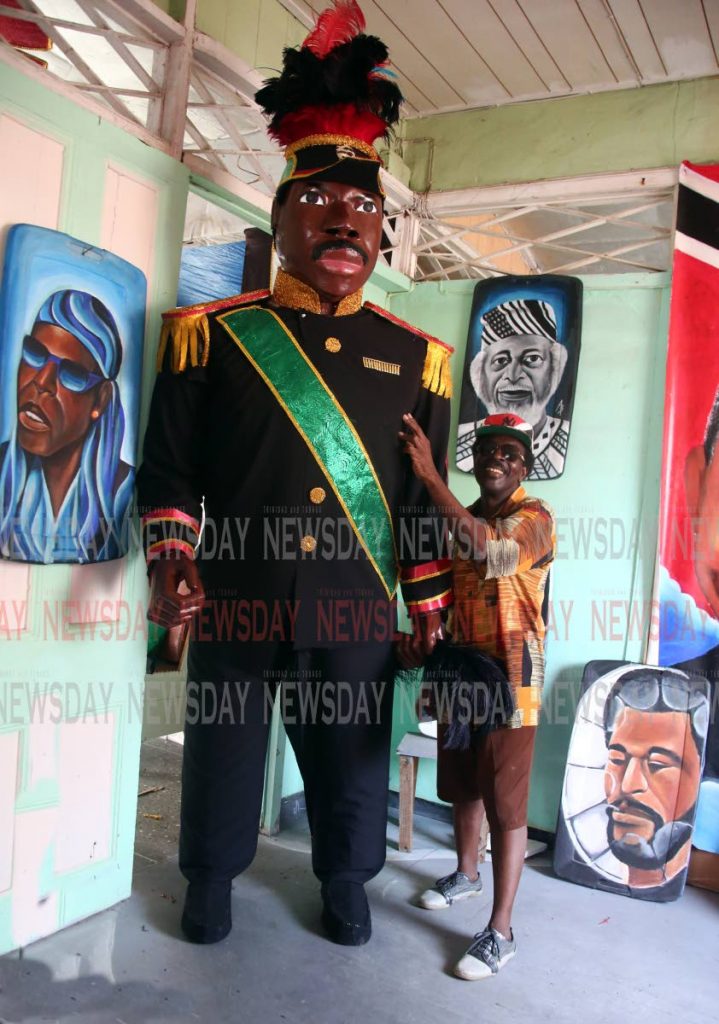A tribute to Garvey

A statue of pan-Africanist Marcus Garvey built by master wirebender Art Brown (Phillip Charles) will feature as a special display at tomorrow's Emancipation Day parade in Port of Spain.
The Emancipation Support Committee (ESC) commissioned the masmaker to build the statue of the Jamaican-born political activist who was a leader in the early 20th century black nationalist movement in the West Indies, US and across the Africa diaspora. The statue will be mounted on a float and is expected to lead the parade.
Brown, who has been wirebending for the past 40 years, felt immense pride in capturing the iconic leader.
“I feel real happy because this is something they need to see in the parade, because of the history of Marcus Garvey. He was one of the people who fought for the emancipation of the people, so this is something great for them.”
He was asked to make the sculpture last year, but did not receive funding – a $10,000 grant from the Ministry of Community Development, Culture and the Arts – until late November.
The sculpture of Garvey in his military-style uniform is made of wire, papier-mâché, and dressed in cloth. The gold trim was made out of lamé, the suit and hat with fabric, feathers on top of the hat, with paint used for the dark-skin colour.
Altogether, it took Brown three months to complete.
The first statue he created, in 2014, was also of a black revolutionary – anti-apartheid freedom fighter and president of South African president Nelson Mandela. The effort was not successful, Brown laughingly recalls.
"That was a disaster and never made it on the road. But this one will be a sure winner."
The Garvey statue returns to Brown’s Calcutta Street, St James home at the end of the Emancipation Day celebrations.
Brown's history in wirebending began in Bermuda but it wasn't until he migrated to Brooklyn, New York that he fully got involved in the artform. There he bent wire for Carnival bands such as Burrokeets, Hawks and the Sesame Flyers in the 20 years he spent in the US.
Upon his return to Trinidad in 2006, Brown did wirebending for bandleader Stephen Derek – another master of the artform – and the bands Wee International, Stephen Derek, Showtime, Tribe and De Crew, as well as Inez Gould's 2013 Carnival queen costume.
Brown is also heavily involved in other aspects of art and Carnival and plans to sell his mas creations and artwork online, since he also does canvas paintings, and mas.
He also wants to teach a new generation of wirebenders.
“I am a professional wirebender. I’m producing some wirebending right now for a children’s band. But I want to start hosting wirebending classes in the future.”
There are only five or six wirebenders still around, he said, as most of the veterans have died.
“We need to produce new skills in the wirebending business. We need the youths who could learn the skill to keep the tradition alive, because that is a kind of dying artform right now, and I won’t mind giving my time if they set up the workshop. I will teach some young people what to do with wire.”
He wants to get the Carnival Bands Association to set up a workshop so he could teach young people how to bend wire and other aspects of masmaking.
About Marcus Garvey
Marcus Garvey, (August 17, 1887 – June 10, 1940) a Jamaican-born political activist, publisher, journalist, entrepreneur, and orator, was the founder and first president-general of the Universal Negro Improvement Association and African Communities League, through which he declared himself provisional president of Africa.


Comments
"A tribute to Garvey"